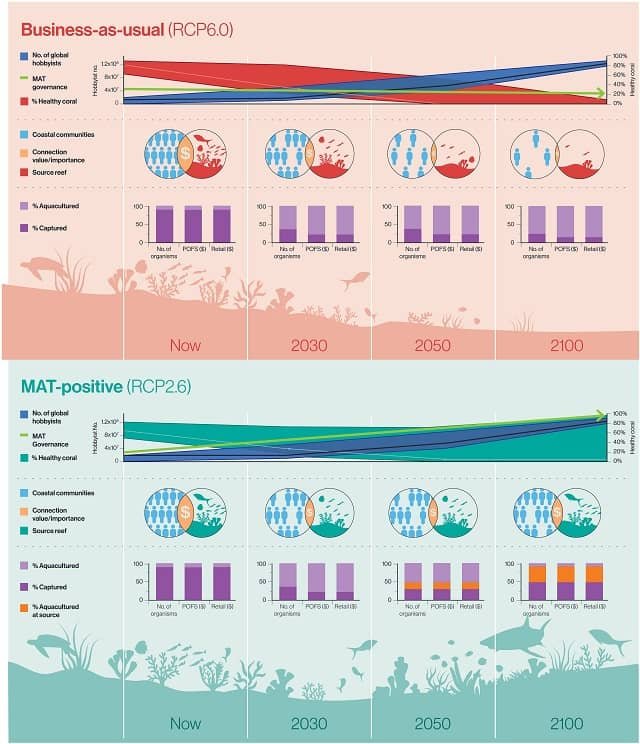
Coral reefs, teeming with vibrant life, serve as a crucial source of income for millions and sustain diverse ecosystems. However, their allure fuels a thriving industry: the Marine Aquarium Trade (MAT). This trade captures and sells fish and invertebrates for home aquariums. While economically significant, concerns about sustainability and its impact on coral reefs have escalated.
New research by scientists from the University of Portsmouth, SciSca, and the University of Salento provides the first global estimate of the number of organisms in the Marine Aquarium Trade, aiming to encourage industry sustainability and coral reef conservation.
A Global Trade with High Value and Uncertain Impact
Globally, around 6 million fishers depend on coral reefs for their livelihoods, significantly contributing to catches in developing countries. However, these species often have relatively low value.
In contrast, MAT focuses on diverse and high-value organisms. This value disparity and incomplete data have led to calls for stricter regulations or even a total trade ban.
Species traded for aquariums fetch a higher price per kilogram compared to fish for consumption. For instance, the average price achieved by MAT is $148 per kg, while tuna is $3 per kg.
Quantifying the Trade: A First Step Toward Sustainability
To comprehend MAT’s true impact and guide sustainable practices, researchers conducted the first global analysis of the quantity, diversity, and biomass of traded organisms. The findings reveal a surprising landscape.
The study estimates there are currently over 8,000 retailers worldwide and 6.7 million marine hobbyists. This number is expected to increase to 45 million by 2100 based on population growth and increasing wealth.
The study unveils that MAT trades around 55 million organisms annually, translating to a retail value of $2.15 billion. This places it on par with significant fisheries like tuna, underscoring its economic importance.
Identifying Overexploited Species and Regions
Over 25% of all known marine species, including high-value fish and organisms, inhabit coral reefs. These ecosystems are crucial for millions, providing a quarter of all fish caught by developing countries bordering reefs.
To assess sustainability, researchers calculated risk indices for different species and regions. They estimated around 500 species are regularly traded in MAT, with 210 fish and invertebrates.
Their analysis identified 25 species/genera, including snail species, hermit crabs, and the Bangaii cardinalfish, facing “extremely high” risk, and classified the seas of Indonesia and Sulu-Celebes as experiencing the highest levels of exploitation.
A Changing Future: Aquaculture or Sustainability?
Scientists warn that the aquarium trade stands at a crossroads due to threats from global climate change and other stressors.
As the hobbyist population continues to grow, researchers predict several potential scenarios. Without effective management and conservation efforts, MAT could shift towards aquaculture-based practices, detaching the industry from local communities and potentially exacerbating reef degradation.
Lead author Professor Gordon Watson of the University of Portsmouth stated, “We know MAT puts pressure on key habitats, but it can also help stimulate enthusiasm for marine conservation and is a valuable source of income for many communities.”
Despite growing awareness of MAT’s environmental impacts, the study’s authors caution that without changes, it could transform into an aquaculture-dominated industry. This would involve cultivating species away from reefs and the associated coastal communities that rely on them to sustain their economies, or adopting more destructive fishing methods.
The study has outlined several ways MAT can become more sustainable:
- Evaluate stock status of high-risk species and implement stock management.
- Address mortality in the supply chain.
- Support local coral reef protection and restoration programs.
- Governance structures, similar to those for tuna, are needed.
- Successful introduction of the Fairtrade/MSC certification system to help implement these measures.
A “MAT-Positive” Future: Balancing Beauty with Responsibility
“The marine aquarium trade is an enormously valuable industry that has the potential to bring about change, providing a framework for fishers and governments to protect reefs and, as a result, the communities that depend on them,” added Professor Watson.
“But the lack of data is amplifying calls for an international trade ban. Our study contributes somewhat to filling these gray areas.”
The future of MAT depends on a “MAT-positive” approach prioritizing evidence-based management, consumer education, and incentivizing sustainable practices. By addressing social, economic, and biodiversity inequalities associated with the trade, we can ensure its long-term viability while protecting vital coral reef ecosystems.
Professor Watson said, “The trade is at a crossroads, and governance decisions in the near future are critical to its long-term future. These choices can be summarized into a ‘business-as-usual’ approach or a ‘MAT positive’ one.”
This article serves as a starting point for future discussions and actions. As we continue to learn more about MAT and its impact, we can work together to ensure a sustainable future for both the industry and the coral reefs it depends on.
The document concludes that a ‘MAT-Positive’ future is conceivable but requires real actions on climate change, evidence-based management, consumer education, incentivization of sustainable practices, and assessments of overexploitation to ensure MAT becomes a ‘force-for-good’ and a paradigm for sustainable fishing on coral reefs.
Reference (Open Access): Gordon J. Watson et al., 2023. Can the global marine aquarium trade (MAT) be a model for sustainable coral reef fisheries?. Sci. Adv. 9, eadh4942 (2023). DOI: 10.1126/sciadv.adh4942 Link to the article
Note: Compiled with information from the press release and the scientific article.

